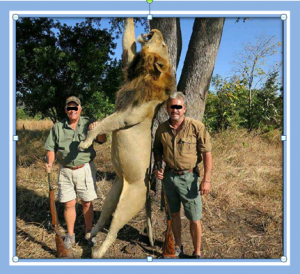News
Latest Lion Aid News
Another computer model to justify continued lion hunting?
Saturday 4th January 2014

Catch of the day A recent publication in Proceedings of the National Academy of Sciences by Charles Edwards and co-authors has been making the rounds on the “science explained” websites. Unfortunately, many of the reporters on such sites swallowed the hook without looking at the meat. The article had the unfortunate title “Data-poor Management of African Lion Hunting using a Relative Index of Abundance” – I would suggest the first seven words explain it all. Bear with me while I explain a few things relevant to this publication:
So that is a bit of background. Now let’s progress to the next stage, please bear with me again for a while before I get to the “meat” of the most recent computer model about how to hunt lions.
OK, now to the paper itself. The authors say that “Deriving robust means to set sustainable limits to exploitation is now a well developed science, increasingly applied to marine fisheries and referred to as management strategy evaluation (MSE)”. And they then go on to develop a model for lion hunting using “a control rule that is robust to incomplete knowledge of resource status or its response to harvesting, implicitly conforming to the precautionary principle of resource management”. Hmmm. Then they profess that lions can be sustainably harvested even in the absence of information on population size. How? Just by tracking success rates of trophy hunters – low success rates mean that there are very few lions in the area, and high success rates mean there are plenty. So no need for quotas, just gauge hunting success and all will be fine. This comes back to the fisheries model. There is really no way to determine how many fish are in the sea. So, as a measure of judging how sustainable fisheries are, just see how difficult it is to catch fish. If most boats come back with a poor catch, then there are not many fish left. But if the boats come back with lots of fish, then there are plenty. So adjust your fishing quotas accordingly. And according to the authors, the same can be applied to lion hunting. In their defence, the authors do acknowledge (in writing, but not so much in the parameters of their model) that the “six year rule” is likely not universally applicable, enforceable, or measurable; that male lion hunting has consequences on cub survival and future reproduction within hunted populations; that hunting of lions is facilitated by setting out baits to make “lion fishing” more effective than some hunter walking around in the bush and “coming across” a huntable lion, etc. They also mention in passing that hunting operators “might” not be ethical in selecting lions of appropriate age for their clients to be shot. An understatement that has affected both fishing harvests and lion hunting to be sure. They do not mention that hunting operators place baits on the borders of protected areas to lure males into their fishing grounds , and that hunting operators rely on the presence of resident female lions to lure both adult males and dispersing males into the hunting concession. They do not mention that their model relies on a minimal level of age compliance that hunting operators vastly ignore. Age restrictions are not enforced in the majority of African nations where lion hunting is legal, and basically have no relevance anyway as the entire premise of the “six year rule” is wrong. No lion should be trophy hunted as the species is in freefall decline. Given the realistic evidence of declines to about 15,000 lions remaining on the entire continent, why bother with a flawed computer model that promotes the continued trophy hunting of lions? Also, is a fisheries model applicable to lion hunting? No. Is a computer model that predicts that lions can be hunted based on a “data-poor management” model relevant? No. Is this publication in any way relevant to sustainable utilization of lions by trophy hunters? No. Are computer models the way forward in sustainable utilization of lion populations by sport hunters? No. So why has this publication received a certain level of media attention? Doubtless because the funders of the study made the appropriate media phone calls and press releases. Certainly not because the publication has any scientifically based merit for future lion conservation. Picture credit: www.rannsafaris.com/lion.html If you have not already signed up to our mailing list, you can add your name here and keep up to date with our ongoing work and, most importantly, DONATE to support our work to conserve the remaining fragile lion populations. Thank you. |
Posted by Chris Macsween at 13:36
No comments have been posted yet.
Add a new comment
Existing user
New user sign up



